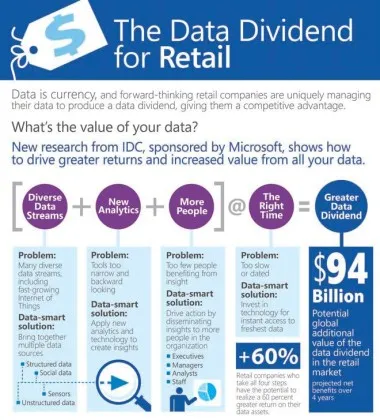
From Data Deluge to Data Insight: Time to reap digital dividend
Data analysis is one of the best ways to help businesses understand their customers, their markets and lots more. This can be done quickly and easily by starting small and using the right business tools and software. Dongbae Park, director, Retail Industries, Microsoft Asia-Pacific, explains how retailers can do this to achieve added business insight and competitiveness.
The retail industry in Asia has enjoyed healthy growth and the region remains a destination of choice for global retail chains. However, Asia-Pacific markets are also facing greater competition, higher operational costs and other challenges such as slowing regional economies, high inflation and interest rates.
Retailers need better insights in order to better manage their resources and connect with their customers to overcome these challenges.
This is where data analysis plays an important role.
Asian retailers have a lot of data about their customers; in fact, they are drowning in it. From searching to purchasing, transactions constantly generate data. This data deluge could swamp retailers — or buoy them.
According to a recent IDC study commissioned by Microsoft, retailers worldwide could gain US$94 billion in value over the next four years by improving their synthesis, analysis and use of the data they collect. We call this the “data dividend”.
It used to be that to analyse significant amounts of business data, retailers needed a data scientist using specialised tools and creating jargon-heavy reports. But with business software available today, retailers can start small to plumb their data for better insight. Virtually any store manager can import, drag and drop data to analyse their displays, stock management, customer engagement and more.
Small projects are faster to execute than large initiatives, so retailers can see immediate results — and dividends.
There are several ways retailers can leverage existing data and tools to achieve this. They can:
- Cross the streams: Start by identifying your data silos — such as sales category data, supply data or campaign results — and finding ways to bring them together. How do specific product line sales compare across locations? How do loyalty card sign-ups correlate with preorders or returns? Assessing your data helps you to formulate smarter questions about your business;
- Zoom in: Broad demographic segmentation is giving way to micro segmentation — using more factors to create richer, more individually detailed target groups. Instead of a vast category of women aged 18-35, micro segmentation can give you women in the 25-29 age group who live in specific postal codes, listen to K-Pop, shop five times per month, and drive a third of sales for your top products. Such detail helps businesses personalise offers and service to increase sales;
- Go public:Supplement your proprietary data with public data, much of which is available for free in formats that can be imported directly into spread sheets or other applications. For example, weather data from local weather service providers plus daily sales by store can reveal how weather influences shopper behaviour. Census data can reveal which customer segments are growing fastest in different parts of the country. And data from Twitter and Facebook can reveal customer sentiment and give early insight into trends, especially for new technology or product categories for which your past sales data simply cannot offer guidance on.
An example of big data in action is restaurant chain Blackball, which specialises in Taiwanese tea and desserts.
Blackball uses perishable components in its desserts, so it is critically important to get ingredients to the right place at the right time. By building a hybrid cloud solution with Fusionex that leverages Windows Azure HDInsight service, Blackball is able to integrate sales data with regional weather patterns and social media feedback, allowing the company to manage its stock more efficiently and serve its customers better.
Retailers can tread water in the data deluge or dive in to create data dividends. By starting small, with existing data and business tools, retailers can channel a productive data stream that brings insight, informed decision-making and ultimately profit.



















 Advertise
Advertise







